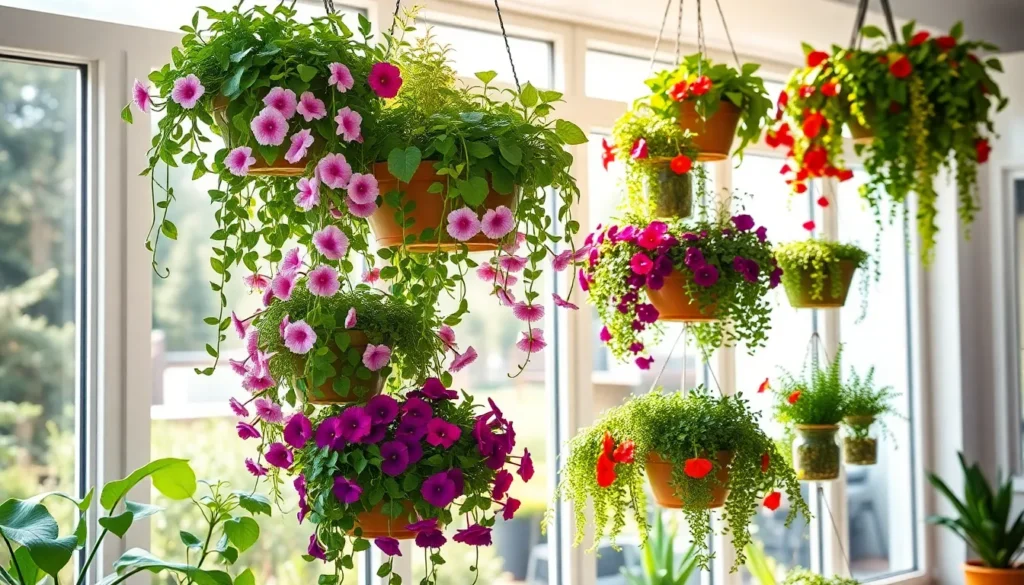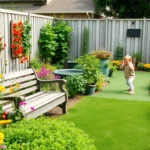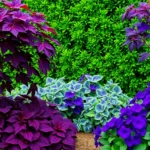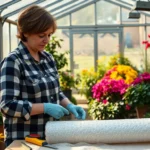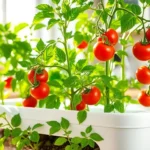Transform your living space into a stunning vertical oasis with creative hanging garden ideas that’ll revolutionize how you think about gardening. Whether you’re working with a tiny apartment balcony or a spacious backyard, we’ve discovered that vertical gardening opens up endless possibilities for growing beautiful plants without sacrificing precious floor space.
We’ve spent countless hours researching and testing the most effective hanging garden techniques that actually work. From cascading herb walls that’ll elevate your cooking game to breathtaking flower displays that become instant conversation starters, these space-saving answers prove you don’t need a traditional garden plot to create something extraordinary.
The best part? Most of these hanging garden projects require minimal investment and can be completed in a weekend. We’re about to share game-changing ideas that’ll help you maximize your growing potential while adding natural beauty to any indoor or outdoor space you call home.
Vertical Herb Gardens for Small Spaces
We’ve discovered that vertical herb gardens provide an excellent solution for maximizing growing space while maintaining easy access to fresh culinary herbs. These compact growing systems transform unused vertical areas into productive kitchen gardens.
Kitchen Window Hanging Herb Collections
Window mounted herb gardens create convenient access to fresh ingredients while cooking. We recommend installing adjustable hanging brackets that accommodate different pot sizes and allow for seasonal changes. Mason jars work exceptionally well for propagating herbs like basil, mint, and cilantro, while small terracotta pots suit established plants such as rosemary, thyme, and oregano.
Light requirements vary by herb type, with most culinary varieties thriving in 4-6 hours of direct sunlight daily. South facing windows provide optimal growing conditions, though east and west facing locations also support healthy herb development. We’ve found that rotating plants weekly ensures even growth and prevents leaning toward the light source.
Watering systems for window collections benefit from consistent moisture monitoring. Drainage becomes critical in hanging arrangements, so we always include saucers or use self watering containers. Overwatering kills more hanging herbs than underwatering, making proper drainage essential for long term success.
Tiered Hanging Planters for Culinary Herbs
Multi level growing systems maximize vertical space efficiency while creating stunning visual displays. We construct tiered arrangements using macrame hangers at varying heights, typically spacing them 12-18 inches apart to prevent shadowing. This configuration allows taller herbs like sage and rosemary on upper levels, with trailing varieties like thyme and oregano below.
Planter selection impacts both aesthetics and plant health in tiered systems. Coconut fiber baskets provide excellent drainage and natural appearance, while plastic containers offer lightweight durability and water retention. We prefer 6-8 inch diameter planters for single herb varieties and 10-12 inch containers for mixed plantings.
Harvesting strategies become more efficient with properly designed tiered systems. We position frequently used herbs like basil and parsley at eye level for easy picking, while placing occasional use varieties such as sage and bay leaves higher up. This arrangement reduces daily maintenance time and encourages regular harvesting that promotes continued growth.
Cascading Flower Displays That Create Visual Impact
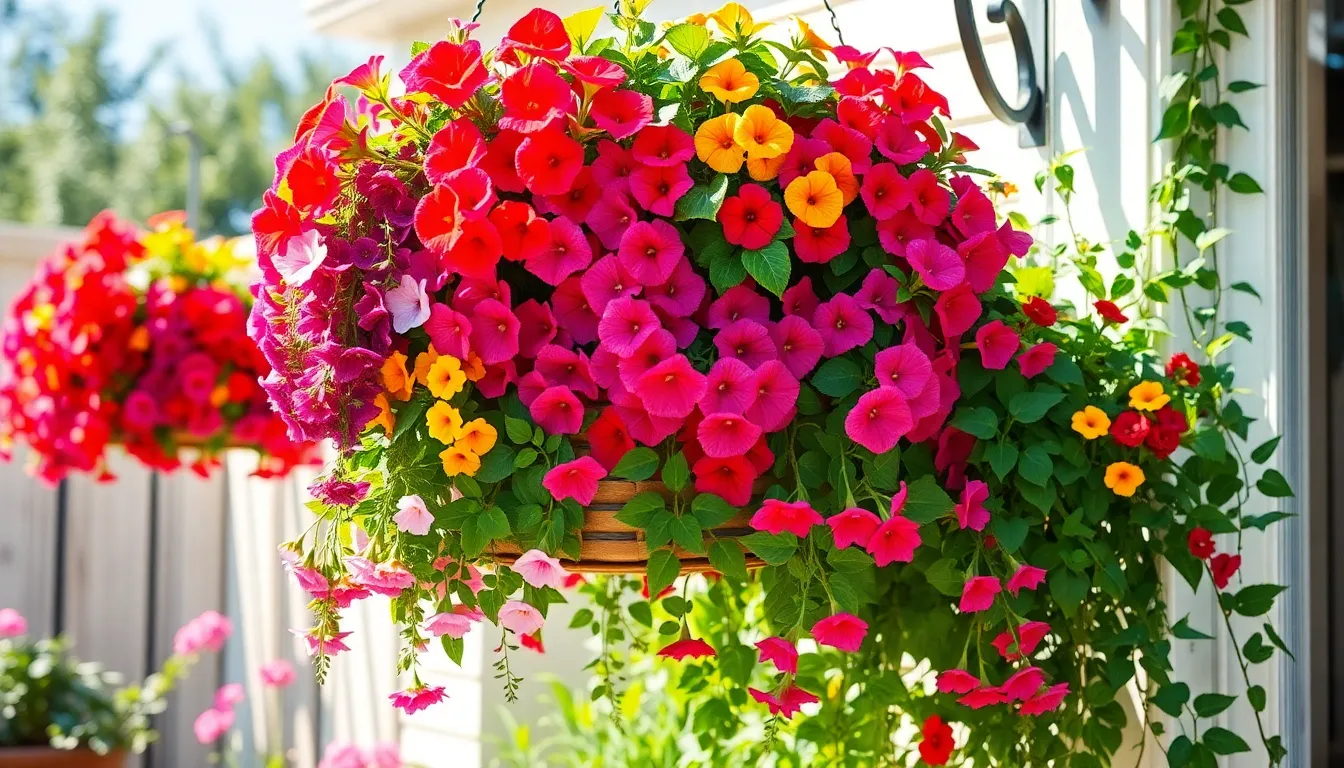
Moving beyond herbs, we’ll explore spectacular cascading displays that transform vertical spaces into living waterfalls of color and texture.
Trailing Petunia and Ivy Combinations
Layered hanging displays create stunning visual depth when we combine vibrant petunias with cascading ivy in multi-tiered arrangements. These combinations maximize our vertical growing space while delivering continuous color throughout the growing season.
Cascading petunias serve as the star performers in hanging baskets, offering vibrant blooms that spill over container edges in gorgeous trailing patterns. We’ve found that pairing these colorful flowers with trailing ivy creates a balanced display of both texture and color intensity.
Ivy combinations work exceptionally well when we layer different plant types within the same hanging system. Combining trailing ivy with flowering vines like clematis or nasturtiums produces ever-changing displays that change throughout the seasons.
Vine and flower mixes allow us to create personalized arrangements that reflect our style preferences. These combinations provide the structural green backdrop of ivy while featuring the seasonal color bursts that petunias deliver consistently.
Multi-Level Hanging Basket Arrangements
Tiered planters maximize our vertical gardening potential by creating multiple growing levels within a compact footprint. These stacked arrangements can accommodate herbs, flowers, and greenery simultaneously for diverse visual interest.
Multi-level displays work best when we place larger or more vibrant plants at the top levels to draw attention upward. This placement strategy creates natural focal points that guide the eye through our entire hanging garden composition.
Stacked hanging baskets offer practical answers for small spaces while delivering maximum visual impact. We can adjust the spacing between levels to accommodate different plant growth patterns and ensure adequate light reaches all tiers.
Focal point creation becomes effortless when we strategically position our most eye-catching plants at prominent levels. These arrangements transform ordinary vertical spaces into captivating garden features that serve as natural conversation starters.
DIY Macrame Plant Hangers for Bohemian Style
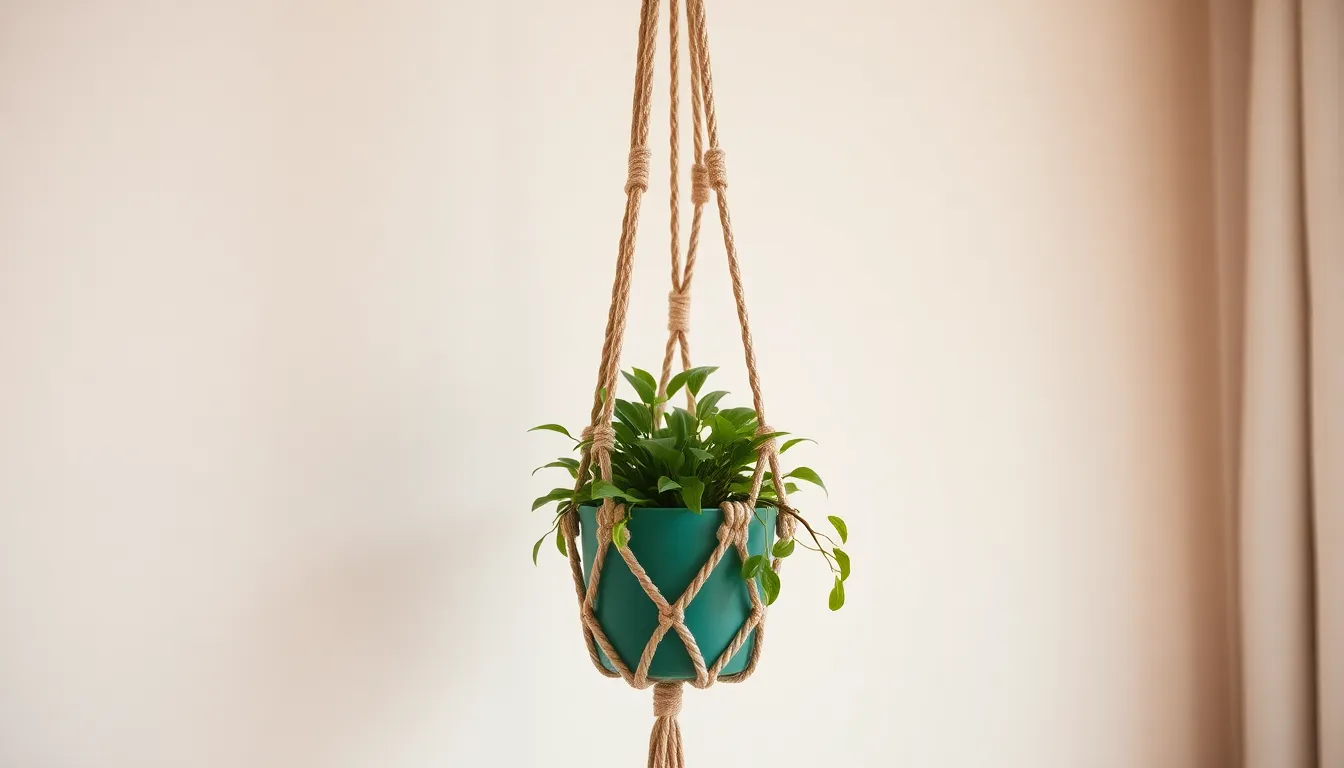
We’ve discovered that macrame plant hangers create the perfect bohemian aesthetic while adding vertical interest to any space. These handcrafted pieces transform ordinary hanging planters into stunning artistic focal points that complement cascading displays beautifully.
Basic Macrame Knot Techniques for Beginners
Learning fundamental macrame knots opens up endless possibilities for creating custom plant hangers that match your space perfectly. The Lark’s Head Knot serves as the foundation for most hanging designs, allowing us to attach our 3mm 3ply cotton cord securely to wooden rings or mounting points.
Square knots provide the structural backbone of most plant hanger designs, creating sturdy cradles that support various pot sizes safely. We recommend practicing this essential technique first, as it appears repeatedly throughout most macrame projects and ensures your planters remain secure.
Wrap knots add decorative elements while reinforcing connection points between different sections of your hanger. These finishing touches prevent fraying and create polished appearances that elevate DIY projects to professional quality standards.
Online tutorials through macrame schools offer step by step guidance for mastering these three core techniques effectively. YouTube platforms feature comprehensive mini macrame plant hanger tutorials that demonstrate proper tension and spacing for optimal results.
Vintage-Inspired Rope and Cord Designs
Textured materials create authentic vintage aesthetics that transport hanging gardens back to classic bohemian eras. We’ve found that incorporating multiple rope weights and fiber types adds visual depth while maintaining structural integrity for heavier planters.
Colorful cord combinations allow us to customize hangers that complement existing room decor while maintaining vintage charm. Pinterest boards like Meg Nordmann’s showcase intricate pattern combinations that incorporate traditional knot work with contemporary color palettes.
Natural jute and hemp ropes provide earthy textures that enhance vintage inspired designs authentically. These materials age beautifully over time, developing character that mass produced hangers simply can’t replicate.
Etsy marketplaces offer both handmade vintage style hangers and DIY kits for those preferring guided creation processes. These resources include pre cut materials and detailed pattern instructions that ensure successful project completion for beginners.
| Material Type | Best Use | Vintage Appeal |
|---|---|---|
| 3mm Cotton Cord | Lightweight plants | Classic bohemian |
| Natural jute rope | Heavy ceramic pots | Rustic farmhouse |
| Hemp cord | Medium plants | Earthy organic |
| Textured cotton | Decorative displays | Artisan crafted |
Repurposed Container Gardens That Save Money

Transforming everyday household items into stunning hanging gardens offers an economical way to expand our vertical growing space. We’ve discovered that repurposed containers not only reduce waste but also create unique garden features that cost significantly less than store-bought planters.
Mason Jar Hanging Gardens
Mason jar planters deliver rustic charm while maximizing our budget for vertical gardening projects. We can hang these versatile glass containers from wooden beams or metal rods using sturdy twine or rope, creating simple yet elegant displays throughout our living spaces.
Essential materials we’ll need include mason jars of various sizes, natural twine or decorative rope, a wooden beam or mounting rod, and small plants or fresh herbs. The transparent glass allows us to monitor root development and water levels, making plant care more intuitive for beginners.
Installation becomes straightforward when we secure the rope around the jar’s threading, ensuring each knot can support the weight of soil and water. We recommend starting with lightweight herbs like basil, mint, or small succulents that thrive in contained environments.
Upcycled Plastic Bottle Planters
Plastic bottle gardens transform waste materials into functional growing systems that cost virtually nothing to create. We can cut strategic holes in the middle of various sized bottles, add proper drainage openings, and string them together for unique vertical arrangements.
Materials required include clean plastic bottles, a sharp knife or scissors for cutting, a drill for creating drainage holes, and strong twine or string for hanging. Wrapping bottles in decorative fabric or natural twine enhances their appearance while hiding the plastic construction.
Creative arrangements emerge when we string multiple bottles at different heights, creating cascading garden walls that maximize growing space. This hanging pop bottle method works exceptionally well for trailing plants, herbs, and small flowering varieties that don’t require extensive root systems.
Succulent Hanging Gardens for Low Maintenance
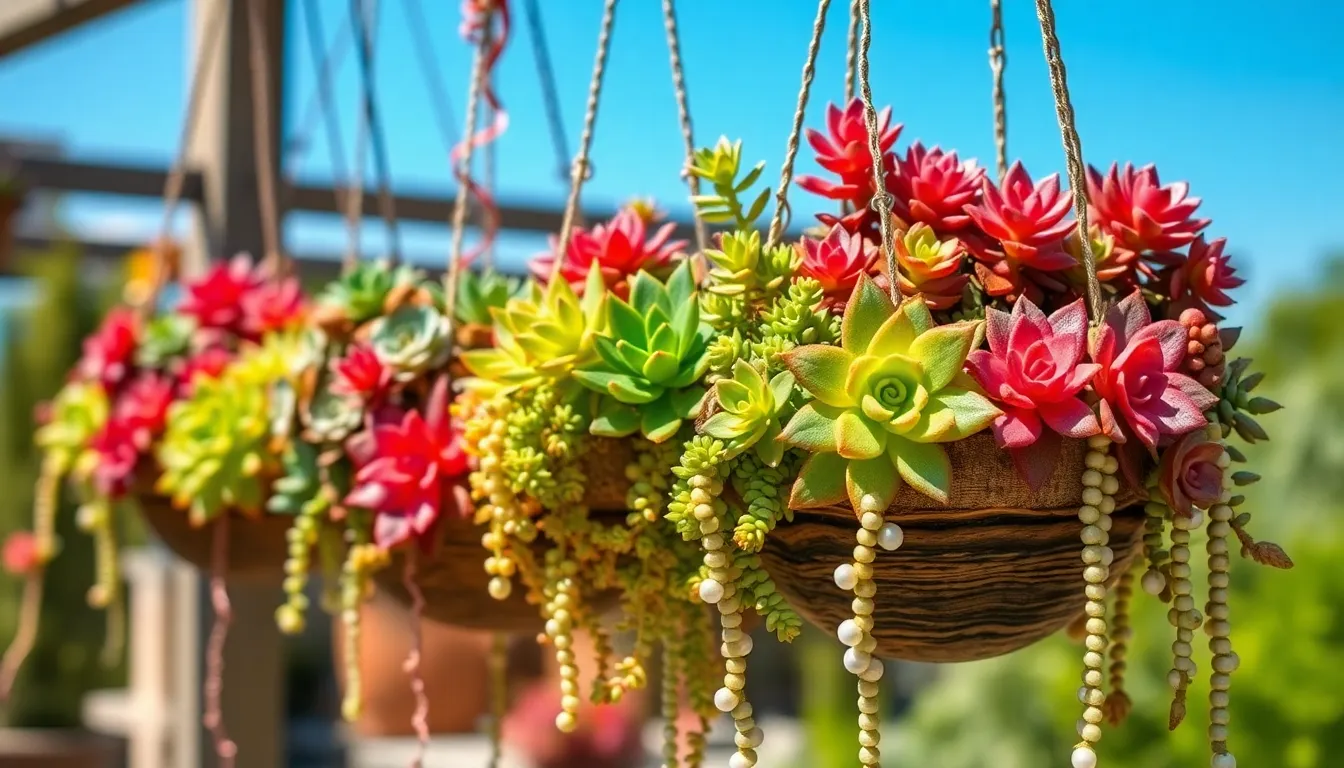
We’ve discovered that succulent hanging gardens offer the perfect solution for busy gardeners who want stunning vertical displays without constant maintenance. These resilient plants thrive in hanging arrangements while requiring minimal water and care.
Drought-Resistant Plant Combinations
Combining succulents with cacti creates the ultimate low maintenance hanging garden that can withstand extended dry periods. We recommend pairing Echeveria, Crassula, and Sedum varieties with small cacti to achieve a diverse yet cohesive drought resistant display.
Trailing succulents add cascading beauty that transforms ordinary hanging baskets into living sculptures. String of Pearls creates delicate curtains of green beads, while Burro’s Tail produces thick, rope like stems that drape elegantly over container edges.
Mixed succulent arrangements work best when we group plants with similar water and light requirements together. Desert varieties like Haworthia and Aloe complement each other beautifully while maintaining their individual characteristics in shared containers.
Self-Watering Hanging Succulent Systems
Built-in water reservoirs revolutionize succulent care by allowing plants to absorb moisture as needed without risk of overwatering. These innovative planters feature separate water chambers that provide consistent hydration while preventing root rot.
Moisture retentive soil mixes specifically designed for succulents help maintain optimal water levels between waterings. We’ve found that adding perlite and coarse sand to standard potting mix creates the perfect balance of drainage and water retention.
Automated watering systems can be integrated into hanging succulent displays using drip irrigation tubes connected to timer controlled pumps. This setup ensures consistent moisture delivery while we’re away, making these gardens truly self sufficient for weeks at a time.
Indoor Air-Purifying Hanging Plant Collections
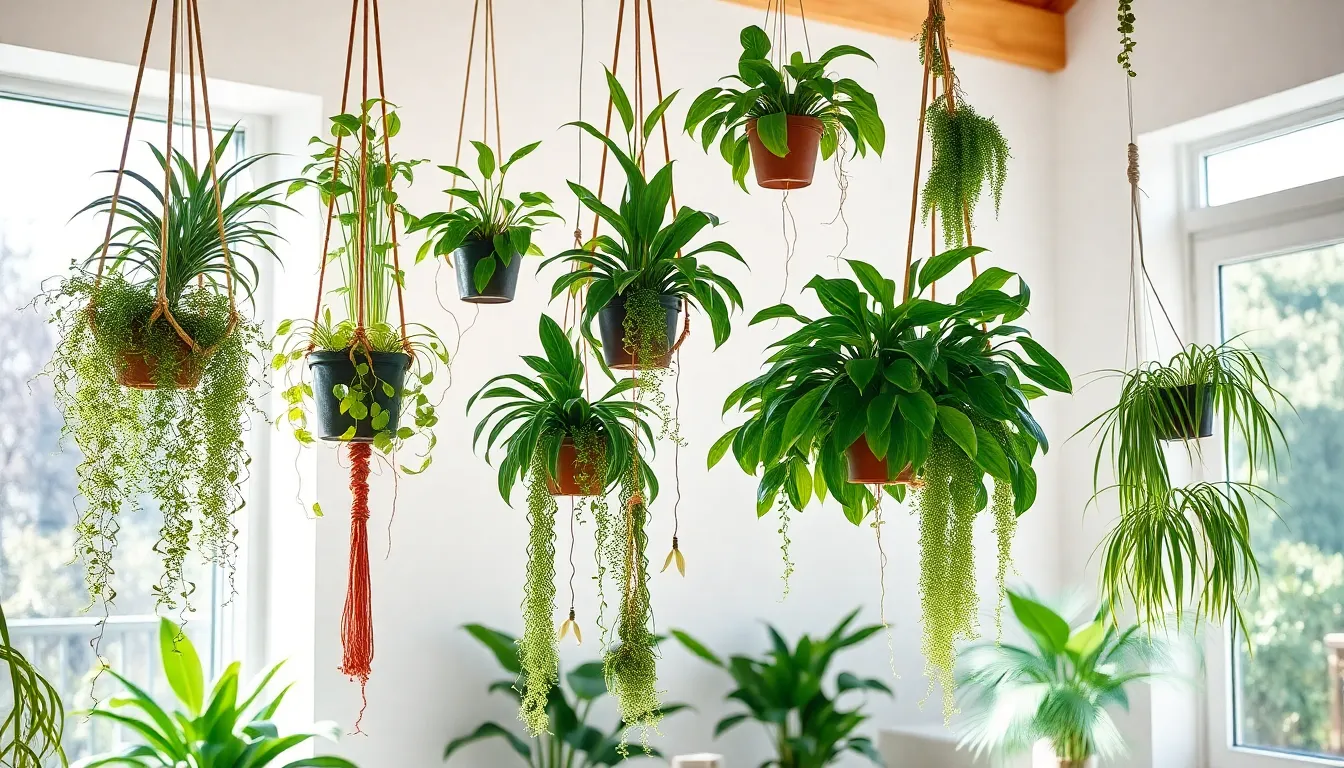
We’re transforming our hanging gardens into natural air filtration systems that beautify our spaces while actively cleaning the air we breathe.
NASA-Recommended Plants for Better Air Quality
Spider Plants (Chlorophytum comosum) top our list as nature’s most reliable air purifiers, removing common household pollutants while producing cascading baby plants that create stunning visual displays. Easy propagation makes these plants perfect for expanding our hanging collections throughout multiple rooms.
Bamboo Palms excel at eliminating various household toxins while generating fresh oxygen, making them ideal centerpieces for our vertical garden arrangements. Their graceful fronds add tropical elegance to any hanging display while working tirelessly to improve our indoor atmosphere.
English Ivy stands out as our most effective benzene fighter, tackling this common household chemical with remarkable efficiency. Trailing vines create beautiful cascading effects that transform ordinary hanging baskets into living air purification systems.
Peace Lilies tackle multiple pollutants simultaneously, removing ammonia, formaldehyde, and trichlorobenzene from our living spaces. Their elegant white blooms provide visual interest while their broad leaves maximize air cleaning surface area in compact hanging arrangements.
Dracaena Compacta specializes in formaldehyde removal, making it essential for homes with new furniture or carpeting. Compact growth habits suit smaller hanging containers while still delivering powerful air purification benefits.
Strategic Placement for Maximum Benefits
High traffic areas maximize our plants’ air cleaning potential by positioning them where family members spend the most time. Living rooms, kitchens, and home offices benefit most from strategically placed hanging air purifiers that work continuously throughout the day.
Well ventilated spaces enhance our plants’ efficiency by ensuring proper air circulation around each hanging collection. Ceiling fans and natural airflow patterns help distribute cleaned air throughout our rooms while preventing stagnant air pockets.
Mixed arrangements combine different plant species to tackle broader ranges of household pollutants simultaneously. Pairing spider plants with peace lilies creates comprehensive air cleaning systems that address multiple toxins while adding visual variety to our hanging displays.
Layered heights position larger air purifying plants at eye level where they can process the most air, while smaller specimens fill upper and lower spaces. Tiered macrame hangers and adjustable chains allow us to create ever-changing vertical arrangements that maximize both visual appeal and air cleaning coverage.
Seasonal Hanging Garden Themes
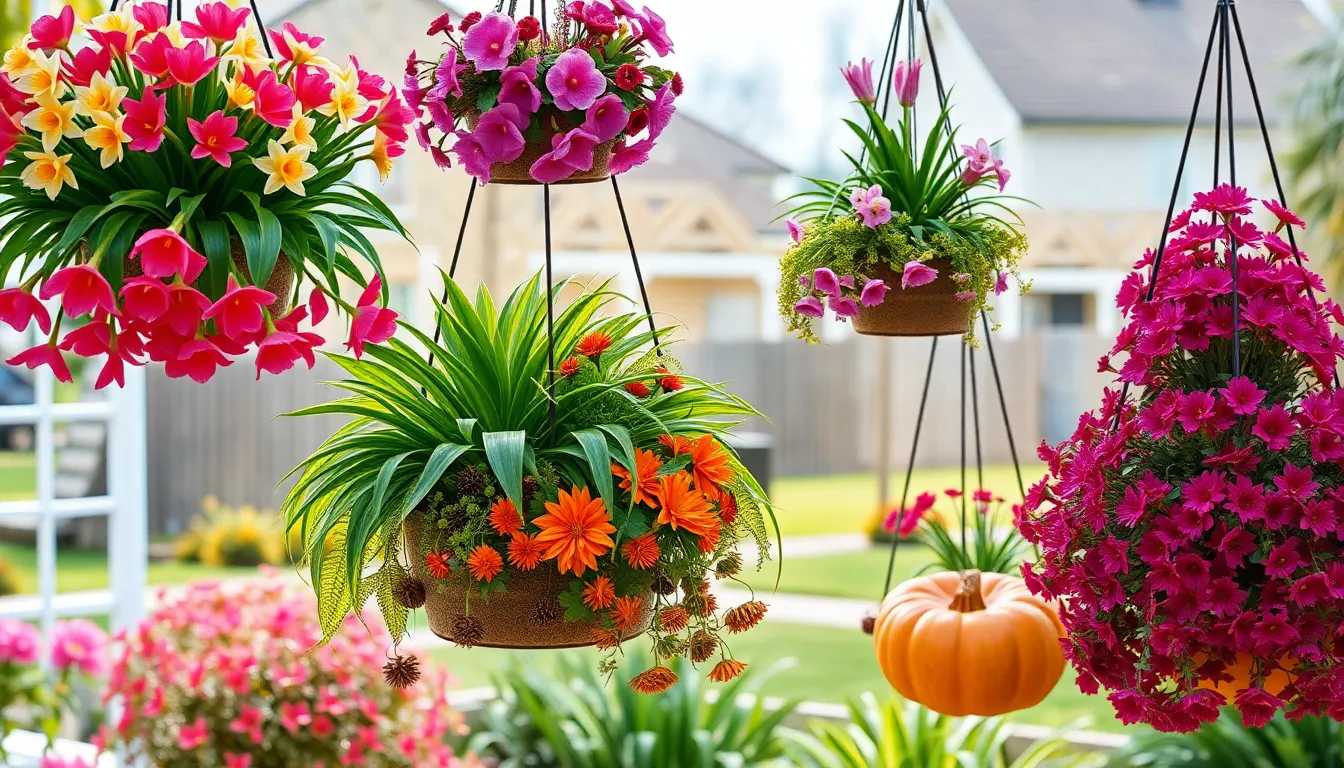
We’ve discovered that seasonal hanging gardens let you celebrate nature’s changing beauty throughout the year while maintaining stunning vertical displays.
Spring Bulb Hanging Displays
Spring Bulb Hanging Displays transform ordinary baskets into vibrant seasonal showcases featuring tulips, daffodils, and crocuses. We recommend planting bulbs in mesh pots filled with well-draining soil during late fall or early winter. Hanging these containers before sprouting occurs allows us to enjoy effortless blooms at eye level.
Tulips create dramatic color statements in purple, red, and yellow varieties. Daffodils provide cheerful yellow and white combinations that brighten any space. Grape hyacinths offer compact blue spikes perfect for smaller hanging arrangements.
Implementation becomes straightforward when we select containers with adequate drainage holes. Position these spring displays in areas receiving morning sunlight for optimal blooming. We’ve found that grouping different bulb varieties creates layered flowering periods extending the display season.
Summer Tropical Plant Arrangements
Summer Tropical Plant Arrangements bring lush rainforest vibes to hanging gardens through ferns, orchids, and bromeliads. We create these arrangements using hanging baskets that accommodate high humidity loving plants. Boston ferns cascade beautifully while air plants add unique textural elements.
Orchids provide exotic flowering focal points in white, pink, and purple varieties. Bromeliads contribute bold foliage patterns and colorful central cups. We enhance tropical themes by incorporating decorative shells, smooth pebbles, or driftwood pieces.
Plant selection focuses on species thriving in warm, humid conditions with filtered light. Position these arrangements in partially shaded areas receiving bright indirect sunlight. We maintain optimal growing conditions through regular misting and consistent moisture levels.
Fall Harvest Hanging Gardens
Fall Harvest Hanging Gardens celebrate autumn’s rich colors using asters, mums, and sedum varieties resistant to cooler temperatures. We design these displays incorporating seasonal decorations like pinecones, dried corn husks, and miniature pumpkins. Cold hardy plants ensure continued beauty as temperatures drop.
Asters provide purple and white daisy like flowers blooming through frost. Mums offer traditional fall colors in bronze, orange, and deep red varieties. Sedum contributes succulent textures with pink or red autumn flowering.
Seasonal decorations enhance the harvest theme when we add natural elements like acorns, wheat stalks, or colorful autumn leaves. These arrangements transition beautifully from late summer through early winter. We position fall displays in locations receiving full morning sun for vibrant color development.
Modern Geometric Hanging Planters
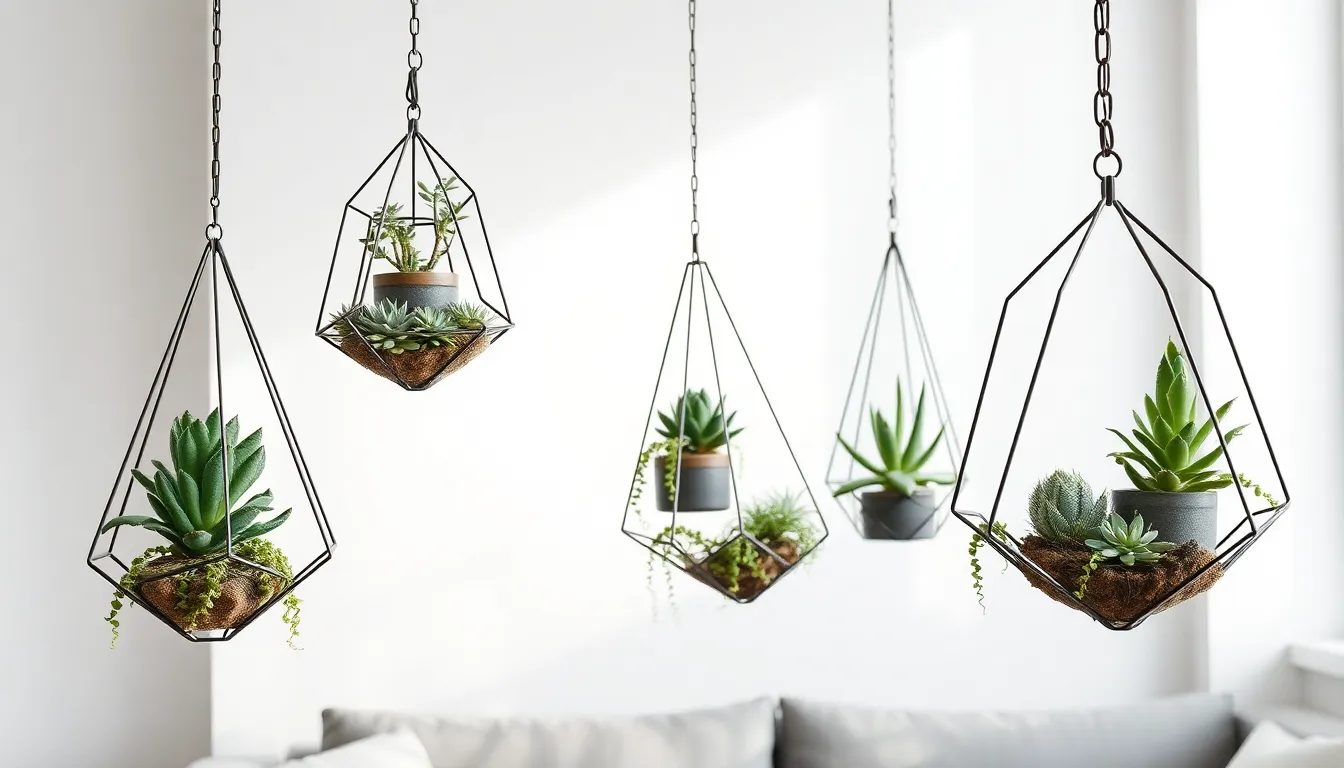
Contemporary hanging gardens embrace clean lines and structured designs that complement modern interior aesthetics. We’ve discovered that geometric planters create striking focal points while maintaining the sophisticated minimalism today’s homeowners desire.
Triangular and Hexagonal Design Options
Triangular planters offer ever-changing visual appeal through their unique three-sided geometry. We can hang these modern triangular planters from ceilings or mount them directly on walls, creating eye-catching displays that transform ordinary vertical spaces. Their angular design works particularly well with architectural elements like exposed beams or contemporary furniture.
Hexagonal planters deliver sleek sophistication with their six-sided structure that naturally draws the eye. We find these planters excel at showcasing succulents and small plants while maintaining a polished appearance. Multiple hexagonal units can be arranged in honeycomb patterns, creating larger geometric installations that serve as living wall art.
Pattern arrangements maximize visual impact when we combine multiple geometric shapes. We recommend grouping triangular and hexagonal planters at varying heights to create depth and movement. This approach transforms single planters into comprehensive design statements that enhance modern living spaces.
Minimalist Metal Frame Constructions
Industrial column arrangements feature sleek metal planters suspended in straight vertical lines. We position these industrial planters in columns with plants randomly placed throughout each tier, creating impactful displays that maintain clean aesthetic lines. The structured placement contrasts beautifully with organic plant growth.
Metal grid systems provide flexible frameworks for customizable hanging gardens. We use these metal frame grids to create organized planter displays that can be easily reconfigured as plants grow or seasons change. The minimalist structure supports various planter sizes while maintaining visual cohesion.
Contemporary finishes in matte black, brushed steel, or powder-coated white complement modern decor themes. We select metal frame materials that resist corrosion while supporting plant weight safely. These durable constructions ensure long-lasting beauty in both indoor and covered outdoor applications.
Edible Hanging Gardens for Fresh Produce
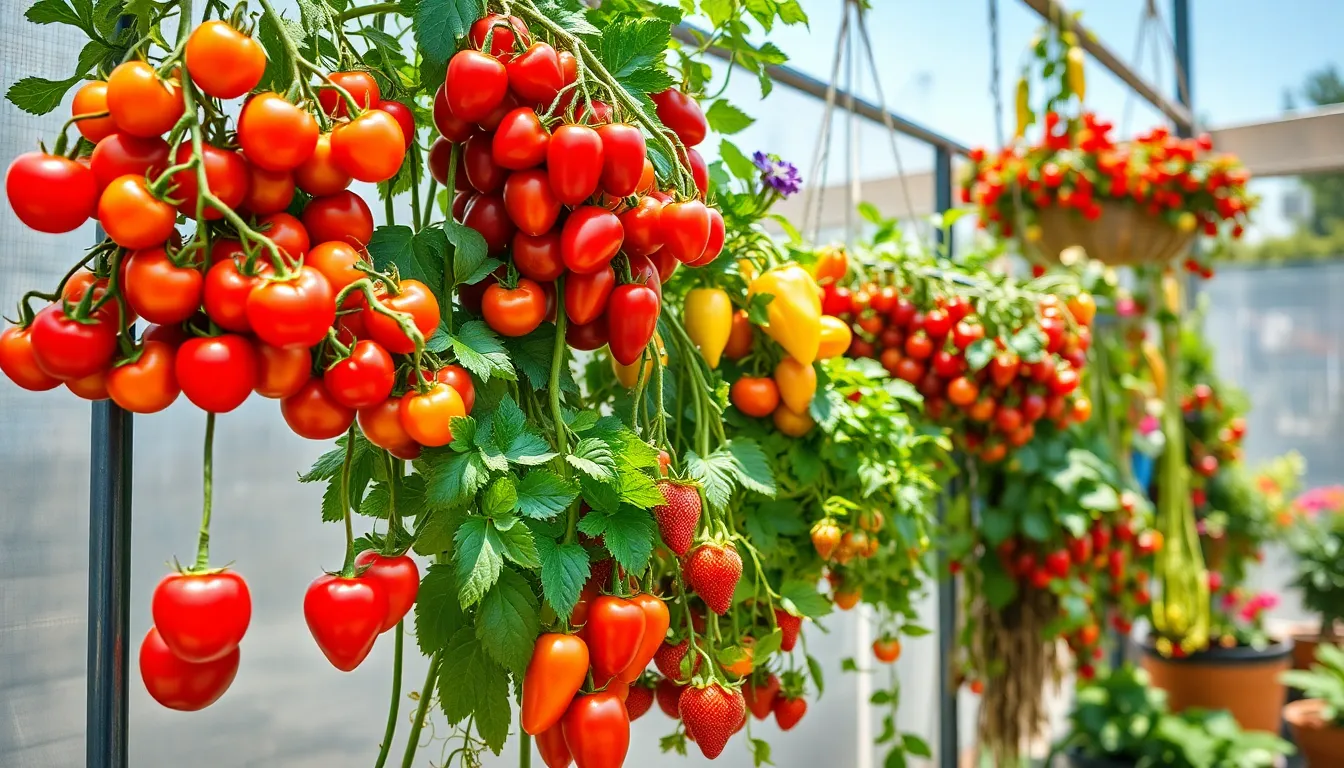
Growing your own food vertically maximizes space while providing fresh ingredients right at your fingertips. These productive hanging systems transform unused vertical areas into thriving food sources.
Cherry Tomato and Pepper Hanging Systems
Cherry tomatoes thrive in hanging baskets because their lightweight fruits reduce the risk of branches breaking under heavy loads. We recommend selecting compact varieties that produce small, flavorful tomatoes perfect for snacking and salads. Positioning these baskets in sunny locations with at least 6-8 hours of direct sunlight ensures optimal fruit development.
Fine mesh supports or small trellises help manage the vining growth of both cherry tomatoes and peppers. Installing these support systems early in the growing season prevents damage to developing branches. Mini cucumber varieties also work exceptionally well in these hanging arrangements, producing crisp vegetables ideal for fresh salads.
Pepper plants adapt beautifully to hanging systems when you choose compact cultivars designed for container growing. These varieties produce full-sized peppers without requiring extensive root systems or heavy support structures. Strategic placement allows easy harvesting while maintaining the plants’ health throughout the growing season.
Strawberry Tower Hanging Gardens
Strawberry towers create stunning vertical displays while maximizing berry production in minimal space. Multi-tiered hanging systems allow you to grow dozens of strawberry plants in the same footprint as a single traditional planter. Each level receives adequate sunlight while the cascading design creates an attractive garden feature.
Day-neutral strawberry varieties work best in tower systems because they produce fruit continuously throughout the growing season. Positioning the tower where it receives morning sun and afternoon shade protects the berries from excessive heat. Regular watering becomes crucial since the elevated position increases evaporation rates.
Rotating the tower weekly ensures all plants receive equal sunlight exposure and prevents lopsided growth. The bottom tier often produces the largest berries due to enhanced root development and nutrient accumulation. Harvesting becomes a delightful daily activity as ripe berries appear at various levels throughout the tower structure.
Leafy herbs and spinach complement strawberry towers by utilizing the shaded areas beneath the berry plants. These companion plants remain protected from common pests like slugs while benefiting from the tower’s watering system. Adding edible flowers such as calendula enhances both the visual appeal and culinary potential of your hanging garden display.
Conclusion
Creating your own hanging garden opens up endless possibilities for transforming any space into a living masterpiece. Whether you’re drawn to the rustic charm of macrame hangers or the sleek appeal of geometric planters we’ve shown you that vertical gardening works for every style and budget.
The best part? You don’t need extensive gardening experience to get started. From simple herb collections to elaborate cascading displays each project we’ve covered can be customized to your exact needs and skill level.
Your hanging garden journey begins with a single planter and grows from there. Start small experiment with different combinations and watch as your vertical oasis becomes the stunning focal point you’ve always wanted in your home.
Frequently Asked Questions
What are the main benefits of hanging gardens?
Hanging gardens maximize vertical space without taking up valuable floor area, making them perfect for small apartments and larger spaces alike. They create stunning visual displays while providing practical benefits like fresh herbs, improved air quality, and natural beauty. These vertical gardens are cost-effective, can be completed over a weekend, and transform ordinary spaces into green oases.
Which plants work best for vertical herb gardens?
Popular choices include basil, parsley, cilantro, mint, and thyme, which thrive in hanging containers. Use mason jars for propagation and terracotta pots for established plants. Consider light requirements and install adjustable hanging brackets to accommodate different pot sizes. Tiered arrangements maximize space while creating visually appealing displays with easy access for harvesting.
How do I create cascading flower displays?
Combine trailing petunias with ivy in multi-tiered arrangements to create stunning visual depth and continuous color. Use layered plant types like flowering vines paired with ivy for personalized arrangements. Place larger or more vibrant plants at top levels to create natural focal points, transforming vertical spaces into captivating garden features.
What materials do I need for DIY macrame plant hangers?
You’ll need vintage-inspired rope or cord, scissors, and measuring tape. Master basic knots like the Lark’s Head Knot and Square Knots for secure hangers. Choose materials based on your plant’s weight and desired aesthetic. Online tutorials and Etsy marketplaces offer excellent resources for beginners looking to create bohemian-style hanging displays.
Can I use recycled materials for hanging gardens?
Absolutely! Mason jars create rustic hanging gardens with easy plant health monitoring. Upcycled plastic bottles transform waste into functional growing systems. These repurposed container gardens are economical, reduce waste, and encourage creative arrangements. Both methods maximize gardening potential while maintaining cost-effectiveness and environmental consciousness.
Which succulents are best for hanging displays?
Drought-resistant combinations like Echeveria, Crassula, and Sedum work well with small cacti. Trailing varieties such as String of Pearls and Burro’s Tail create beautiful cascading effects. Group plants with similar water and light requirements, and consider self-watering systems with built-in reservoirs for low-maintenance care perfect for busy gardeners.
How do hanging gardens improve indoor air quality?
NASA-recommended plants like Spider Plants, Bamboo Palms, English Ivy, Peace Lilies, and Dracaena Compacta effectively remove common household pollutants. Strategic placement in high-traffic, well-ventilated areas maximizes air-cleaning potential. Mixed arrangements with layered heights enhance both aesthetic appeal and comprehensive air purification coverage throughout your living space.
What seasonal plants work well in hanging gardens?
Spring features tulips, daffodils, and crocuses in mesh pots for vibrant displays. Summer tropical arrangements include ferns, orchids, and bromeliads for lush, rainforest-inspired looks. Fall harvest gardens celebrate autumn with asters, mums, and sedums enhanced by seasonal decorations. Each theme emphasizes optimal growing conditions and creative arrangements year-round.
Can I grow edible plants in hanging gardens?
Yes! Cherry tomatoes and peppers thrive in sunny hanging systems using compact varieties. Strawberry tower gardens maximize berry production in multi-tiered arrangements. These edible displays can include companion planting with leafy herbs and edible flowers, creating productive and visually stunning vertical gardens that provide fresh produce.
What are modern geometric hanging planter options?
Contemporary designs feature triangular and hexagonal planters that create striking focal points in eye-catching arrangements. Minimalist metal frame constructions include industrial column arrangements and grid systems providing flexible frameworks. These modern designs enhance visual appeal while ensuring durability and support for various plant types in both indoor and outdoor applications.

